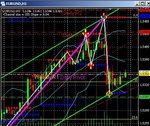Fine post, Teddy.
I'd like a little feedback on some challenges and questions I have regarding day-trading.
1) PRESET TARGET: If I was seting a predetermined profit target on the trade, for example, 5%. I could reasonably achieve that on most trades. However, I'd have one trade that would be turning negative, I'd need intra-day support or resistance to hold to stay in. If there was no hold, the trade would become quite negative, with possibly a loss of 15% or 20%. That, in effect, wipes out three to five days of trading profits.
1. You must always use stop loss whenever you enter any position. Depending on your risk value.
2. Whenever you are comfortably green..shift your stop loss to lock-in. Say you are at 5% profit...you need to lock in at 0 or more %.
3. Intra Day support /Resistance do not work alone. You must have your entry and exit strategies.
4. Those traders that thrive are those that minimise their losses...any time.
2) LETTING IT RUN: A preset target, ensured small incremental wins, but was fragile with regard to overall P/L. Letting a trade run, although, had inherent risks. I'd seen many a nice gain evaporate like dew in a desert within seconds. If I had capped and closed, I'd have a profit. However, some days, I'd let the trade run, and pile up a huge profit.
1. Count small losses and have a big win is ageless in trading. But then you must always protect some profit while letting your profit run! Your exit strategy must inform you to stop the party.
3) INSTRUMENT: I was trading a highly volatile instrument, options on the $RUT. Slippage was rough. I'm considering trading other instruments, like the SPY or QQQQ, which have very small spreads.
1. Volatility is very GOOD to a day trader. Without that...no money will be made. $RUT is quite ok as well as $SPX...QQQQ.
2. What is important is to detemine your entry, exit and risk management.
In US markets, I've heard some day-traders say they prefer to trade the stock, less slippage, as opposed to the option, where you can spend a lot of the day just making up the spread.
1. Option is highly geared and is the den of succesful traders. You know your maximum isk from day 1. You must assign your option asap less time decay.
Questions to the successful day-traders:
1) Are you working with preset gain targets, even if the chart may allow for more of a run?
a. Depends on your strategy.
2) Are you letting trades run with the chart?
a. As in (1)
3) How critical are the instruments you trade? Can an accomplished day-trader trade most anything or are there certain specific instruments that allow you to find an edge?
a. Any instrument that is liquid is good...and volatile is the best.
4) Are you day-trading indexes, as opposed to stocks?
a. Indexes is really better in technical trading. Stock is better in fundamentals. Most liquid Stocks also follow indexes
😕
Dont be.

